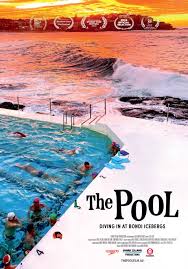
THE POOL
Australia, 2024, 95 minutes, Colour.
Directed by Ian Darling.
This is a cinema essay/poem rather than a narrative about the Icebergs Pool at Bondi Beach, Sydney. In fact, at the end, there is information that this is the most filmed and photographed pool in the world.
For audiences who enjoy beautiful and skilful photography, this is their kind of film. For audiences who need some kind of ongoing narrative to keep their attention and provide some continuity, they will have to rely on some of the stories that swimmers at the pool tell, moments of narrative.
In fact, the film does not give much background to the origins of the pool, except that it opened in 1929 and has been popular ever since. There are statistics given of how many people swim at the pool each year.
On the one hand, the film is a masterclass in cinematography, in editing. There are beautiful scenes of the weather, the sky at dawn, the expanses of the beach and the ocean, the crashing of waves over the pool, vistas of Bondi beach and its background. On the other hand, there is a focus on so many of the men and women, mainly older, and their devotion to the pool, the long years of coming, some even five days a week early in the morning, the regimes, the benefits, the friendships, and the beer drinking at the end of the day.
In fact, the comments of so many of the older men and women are an exhortation to good health and exercise and audiences seeing the benefit.
The population that goes to the pool in the 2020s is significantly white, glimpses of some other participants from Asia and other cultures. In fact, it is often a blokey culture at the pool, especially the men friends over the years, but an equalising of executives with workers the same in their swimming gear. But, there are many women, an increasing number.
Life at the pool is very much controlled by the staff, the importance of racing, the importance of training, the visualising of the various races, the laps, the timing, the qualifications.
Which means then that this is a social document, as mentioned also a cinema poem, reminder of the beach culture of Australia, of Sydney and especially the status of Bondi Beach.
Best to quote some of the statement by the director, Ian Darling.
We set out to make a beautifully cinematic film, where every shot is a stunning portrait and a pleasure to watch. The filmmaking process opened our eyes to the raw beauty of the place, and how the smallest detail; a random wave, a spectacular sunrise, a massive storm, a perfect dive, an individual swimming stroke, the challenge of cold water, the fear of swimming, the healing powers of the water could help us create a story measured and told by the sum of the parts. Making this film also opened our eyes to the incredible cast of characters who populate this place. We didn’t want to make a traditional film where we followed a limited number of people in detail, rather we wanted to gain snippets from many characters who call the pool their home. But more than anything we wanted to make a film where there was just one central character. The pool itself. It just happened to have lots of arms and legs, and an endless well of stories to tell.
This is a time for gentle, poetic, meditative films to also find a place in the canon. We will always need documentaries that highlight injustice, human rights abuses, environmental destruction, and a myriad of other problems. But sometimes we need films that make us feel good about being human again too, and, perhaps, never more than now.